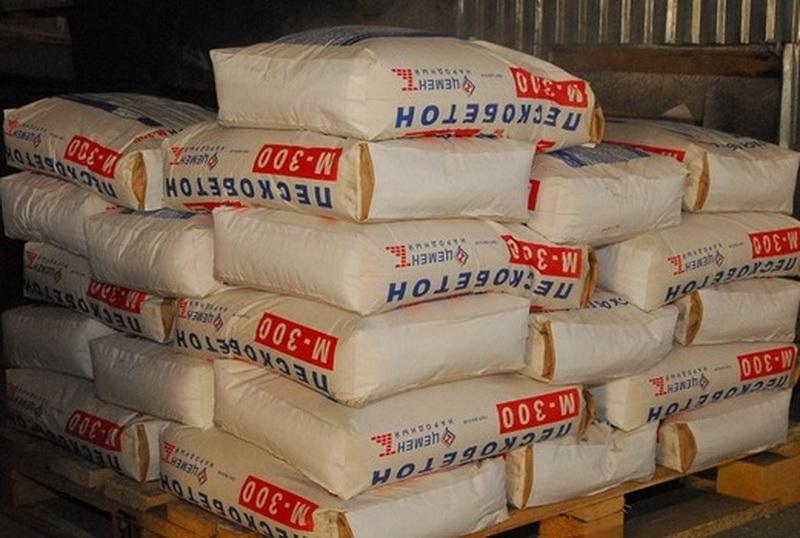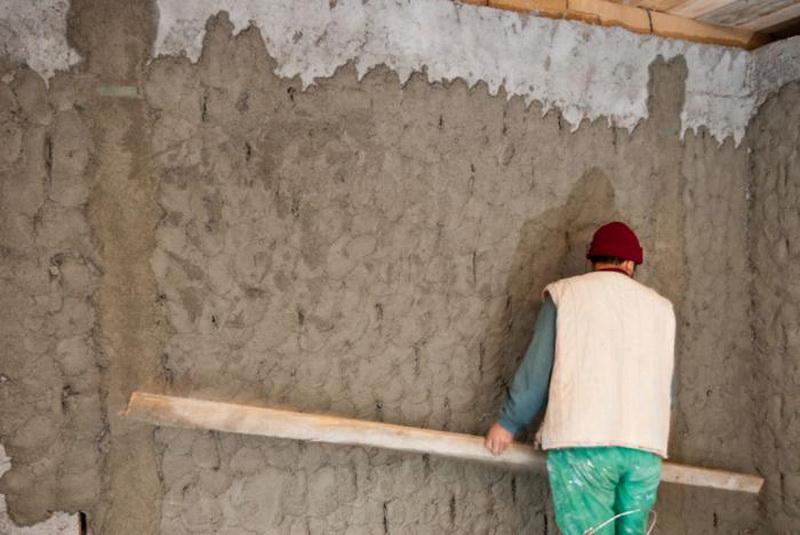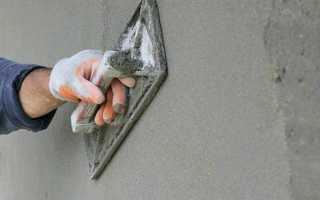Contents
New finishing for walls – plaster peskobetony, appeared at once as soon as mass production of a kind of fine-grained concrete was arranged. What distinguishes a novelty from other plaster structures? What features of application?
Types of a peskobeton
---
good site about plastering walls
---
On structure peskobeton (PB) can be carried to cement and sand mixes. Material takes the intermediate place between concrete and cement plasters.
From the first it is distinguished by lack of large filler, such as crushed stone, from the second – presence of sand of coarse-grained fraction and the increased cement content. Peskobeton (PB) initially intended for the device of a concrete coupler and production of strong plates which require the high durability of the made designs. But it turned out that peskobeton well shows the advantages and as a plaster covering.
To destination peskobeton happens:
- universal (apply both to the device of couplers, and to plastering);
- waterproofing (in production of designs from which the water tightness is required);
- assembly and masonry (use as masonry solution at a brick or stone laying, when plastering);
- wearproof (for production of overlappings, the bases, socles).
Producers produce PB of two types of readiness:
- the dry mixes (an analog plaster CC) marked by BSS;
- ready solution which it is possible to stack at once, the marked BSG.
On characteristics of mix divide on:
- heavy (BST);
- easy (BSL);
- fine-grained (BSM).
Groups of placeability:
- mobile (marking "П");
- rigid (marking);
- superrigid (marking of "SZh").
To decipher the marking specified by the producer (according to GOST 7473-94), it is necessary to know value of letters:
- F – frost resistance (number of cycles of freezing);
- W – water tightness (the indicator is higher, the concrete without infiltration of liquid through a time resists the bigger pressure of water) from 2 to 20;
- In – strength a class (durability is indicated compression in MPa).
Whether it is possible peskobetony to plaster walls
Plaster finishing is applied with several purposes:
- protective (for example, waterproofing, X-ray shielding, heat-retaining, noise-reducing, etc.);
- leveling;
- improving (decorative).
Also plasterers found for Peskobetonny "novelty" application. Plaster peskobetony in cases when alignment of walls, creation of a strong wearproof shirt for facades is required. Material suits for the crude, not heated rooms and also for halls and ladder marches.
Let's consider what peskobeton BSM apply as plaster:
- B7.5 P2 of F200 W4 (earlier marked M100) supports sand fraction 0.8-1.2mm in structure. More often others are used for plaster. Durability on compression it is small (98-100¬ú/cm ²).
- B10 P2 of F200 W4 (before M150) contains quartz and river sand to 2.0 mm. It suits for plastering of facades, a bricklaying. Can move concrete pumps on height up to 52 m.
- B15 P2 of F200 W4 (before M200) can be used for couplers at the device of heat-insulated floors and plasters.
- B20 P2 of F200 W4 (marking old – M250) differs in durability, durability, it suits for filling of floors.
- B25 P2 of F200 W4 (or M300) is universal.
Technology of plastering
- Before plastering cut off power conducting and make preparation of the basis. It is an obligatory first stage of any plaster works.
- Then prepare the leveling solution (for each leveling layer solution is prepared separately).
- The third stage — plastering.
- Care of the applied solution during its curing.
The technology of process is described on packing. Performance of conditions under which plaster walls is obligatory. For example, for "winter" mixes the producer specifies water temperature and air. In work usually carry out at a temperature +5-+25os.
If plaster peskobetony is carried out, it is required to be accustomed to it as mix, being related to cement and sand plaster, has the features. For example, it is impossible to apply solution with a layer more than 6-7 mm as heavy weight under the influence of weight will slip down.
In case the layer needs to be made thicker and to accelerate plastering, the basis is reinforced a grid so that it was in a layer of plaster weight. The net cloth is attached to a wall so that it did not sag.
Preparation of walls for plastering
Preparatory work can be divided into categories conditionally:
- for a renovation;
- for capital repairs;
- in a new building.
In a new building at smooth walls the surface of the basis becomes covered by notches for increase in coupling.
In a bricklaying with the same purpose embroider seams on depth of 1 cm, and nadtsarapyvat top of bricks metal brushes. From walls delete the excess hardware which remained isolate, for example, painting over oil paint. The cleaned surfaces remove dust and ground.
In case of repair delete fragile finishing (wall-paper, filled, paint and also the lagged behind plaster). Repair a splitting off and big cracks. Then sweep away dust, ground, dry.
After priming mount mayachny profiles (if plastering is carried out on beacons).
Solution preparation
The leveling plastering is carried out layer-by-layer (solution for each layer prepares separately and differs in consistence). Therefore it is important correct to calculate amount of solution that was enough for drawing a layer and there was no large amount of surplus.
Mix is involved manually (mixer) or in a rastvoromeshalka, adding powder to water. In both cases the batch has to turn out uniform. In a rastvoromeshalka there is enough 2 minutes of hashing. Before application solution is given 5-10 minutes for insisting.
How to plaster peskobetony
The leveling plaster peskobetony is applied in the following sequence:
- The layer of a nabryzg is carried out solution which has consistence of kefir. The wall before drawing is moistened, dough is thrown a trowel, a ladle or imposed by means of a grater. The layer is not leveled as appointment it – creation of the buffer linking zone. Thickness – 5-6 mm. To a layer do not allow to dry! As soon as "kefir" begins to be matted (to become opaque) pass to the following stage.
- The main leveling layer (soil) is carried out solution more dense. This layer is put, smearing with a grater, after moistening previous. The surface is leveled the rule. Perhaps, it is necessary to do two layers of earth. Anyway to the put weight do not allow to dry as damp conditions are required for cement for a set of durability. After drawing for protection of moisture the wall is covered with damp gunnies or a film. When solution begins to grab, delete beacons, are filled with flute soil.
- For creation of the third layer it is allowed to use polymeric decorative plasters or a cement nakryvka for receiving a smooth surface. Solution with the fine sifted sand of consistence of kefir can be the third layer. In case of finishing facing by a tile this layer is not necessary.
The layer completely will grab in a day. Further finishing is possible in two weeks. Zamatereet (will gain full durability) a covering in 4 weeks. The first day two needs to be protected from drying.
Expense of a peskobeton on 1 m of apartment
As well as in a case with plaster mixes, the consumption of solution is specified in kg square meter of a coupler 10 mm thick (usually from 17 to 30 kg/sq.m). Therefore calculation is conducted similar to flow calculation plaster by CC. Determine the average thickness of a covering (in cm) for alignment of a wall, multiply by the area size (quantity of squares), receive quantity of squares of centimetric thickness.
The last size is multiplied by the expense specified by the producer, receive the necessary weight of peskobetonny mix. It is necessary to add 15-20% for emergency.
For example, area of a wall 2 x 4.5 = 9 sq.m; average thickness of the leveling layer – 3 cm; the PB expense specified by the producer – 22 kg. We multiply: 9 x 3 x 22 x 1.2 = 713 kg (or 18 bags on 40 kg).
Structure of a peskobeton and its characteristic
The main component of fine-grained concrete (one more name) – the portlandtsement forming an artificial stone and connecting by itself sandy grains of filler. Cement knitting – the most expensive component of mix.
Filler of a peskobeton differs in fineness of grains. For a peskobeton river (rounded) sand is sifted through a sieve with a size of cell of 3 mm. Roundish grains of sand of different diameters when laying create structure with the minimum quantity and the sizes of a time, forming more dense material, than cement and sand structures with sandy grains of an angular form. This dense laying gives to a peskobeton the increased resistance to moisture penetration.
Large granules of sand perform function of small crushed stone. For peskobetonny mixes also quartz sand is used. Quartz – breed, strong, steady against destruction, which hardness on Moos's scale – 7. Such filler gives to a composite high resistance to attrition.
On what fraction filler is used, the PB is divided into types:
- melokofraktsionny – the largest grains up to 1.2 mm;
- srednefraktsionny – fineness of grains up to 2.5 mm;
- krupnofraktsionny – grains of 3-4 mm.
Of course, peskobetonny material durability is valuable (on a bend, compression). For plaster use brand PB m300 more often. Density and water tightness do peskobeton resistant to repeated freezing. It is important for finishing of front surfaces in regions with frosty winters.
Producers of a peskobeton try to be allocated in the market, giving to the mixes special qualities. For example, the increased frost resistance (100 cycles against 50) is shown by the mix "Stone Flower".
There are osoboplastichny mixes that is reached at the expense of softeners. But the main advantage of material – durability. All listed qualities are regulated by producers by introduction of additives which are subdivided on action.
Additives happen:
- antifrosty (give the chance to apply mix at subzero temperatures);
- plasticizing (allow to lower a water consumption at a zatvoreniye, to increase durability and density);
- shrink-resistant or expanding (their addition allows to compensate shrinkage of weight when curing);
- stabilizing (prevent water separation when laying);
- accelerating solution hardening;
- the lives (the mobility period) prolonging term;
- the raising strength properties (resistance to external loadings, for example, using up);
- increasing gas-saturation (for receiving the porous PB which is well keeping heat, but differing in the lowered durability), etc.
The main division of a peskobeton is conducted on durability. That is, the artificial stone received from structures will have durability on compression not below provided in the certificate:
- at m100 – not less than 10 MPas (or 100 kgfs/cm2), mix differs in the minimum maintenance of a share of cement and presence of lime;
- m500 and m400 – according to not less than 50 MPas and 40 MPas (it is reached by the increased content of vyokomarochny cement – to 70%).
Intermediate structures have M300, 150, 200 brands. Brands to M150 are used for internal plaster. The bases, first floors and facades plaster peskobetony m300.
Other important technical characteristics:
- adhesion ~ 0/4mpa;
- density (bulk) – 1500 kg/m3;
- rasslaivayemost – 5%.
Advantages
Except a possibility of receiving solution with the guaranteed structure and characteristics, carry to advantages of BP:
- high-durability (resistance to the squeezing and igibayushchy loadings);
- resistance to vibration effects;
- uniformity of weight;
- long term of operation.
Shortcomings
Carry to number of minuses:
- the raised portlandtsement expense (affects cost);
- high hardness of the formed material, its inflexibility to processing;
- big susceptibility to shrinkage (in comparison with polymeric plaster solutions).
Storage and transportation
The PB is packed by the producer into paper multilayered bags from nasypky in 25 or 40 kg. Though a container this rather strong, in transit it is necessary to observe measures of preservation of freight. Transportation by motor transport will cost cheaper.
Here it is important to lay correctly bags and to protect from hit of rainfall. It is also possible to get peskobeton with delivery.
In practice the quality of mix in every month of storage decreases therefore it is more rational to buy the mix produced recently before application in business.
Period of storage in dry warehouses – 6 months (in certain cases – about one year). Despite the impregnated protective top paper cover, it is impossible to store PB in damp rooms. Apply the pallets separating bags from a floor to storage.
Documentation
Now GOST 31357-2007 extends to dry cement construction mixes. As peskobeton belongs to this class CC, it has to be made according to this standard. According to it, for designation of material (except the brand of durability) brands of frost resistance, mobility, the size of grains, appointment, conditions and a way of drawing are specified in marking.
Plaster peskobetony not only is possible, but also is often applicable as the end result at small increase in the cost meets increased requirements to quality and durability of finishing.












 (yet there are no estimates)
(yet there are no estimates)


 In what cases it is possible to put a tile on plaster plaster
In what cases it is possible to put a tile on plaster plaster